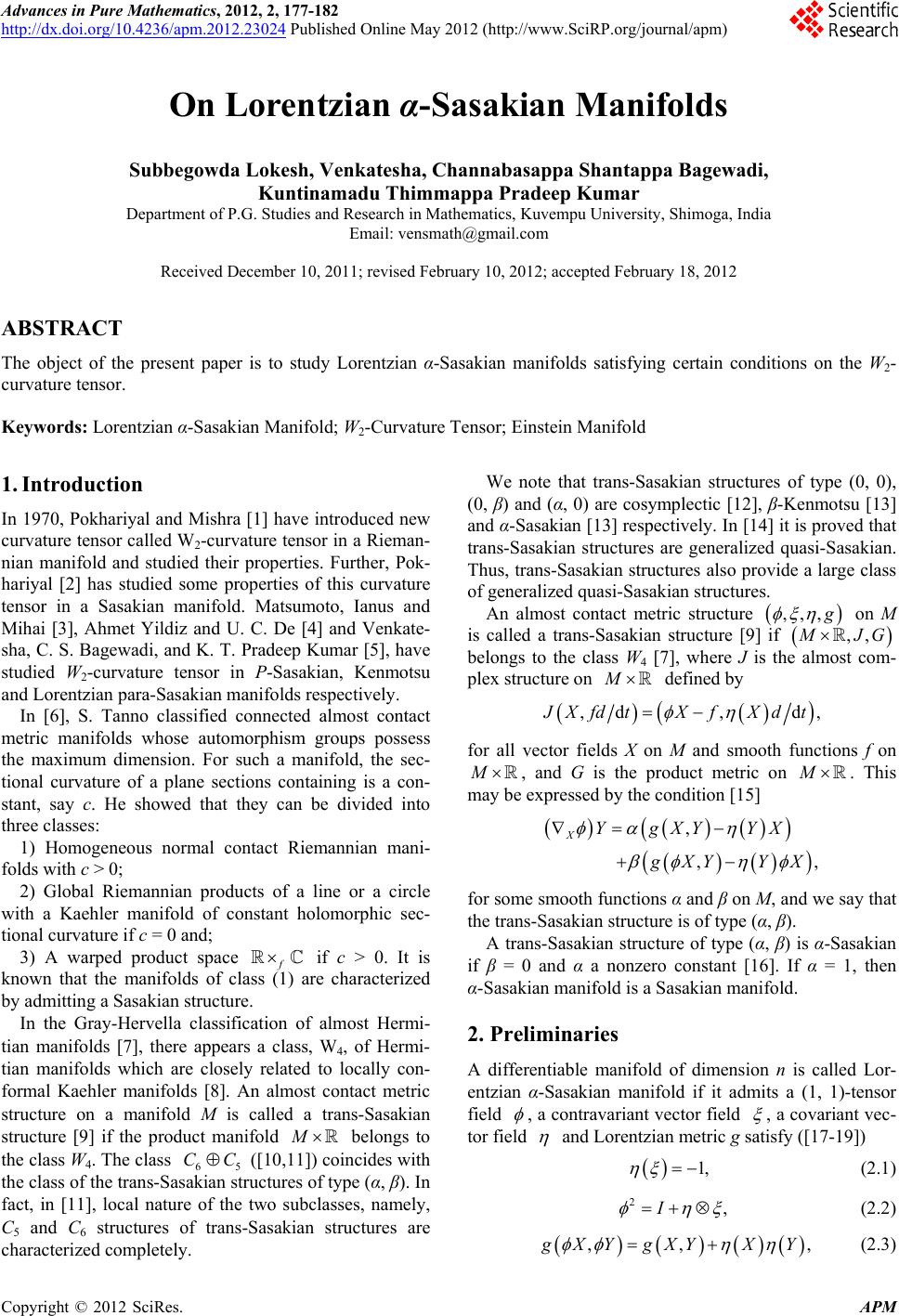 Advances in Pure Mathematics, 2012, 2, 177-182 http://dx.doi.org/10.4236/apm.2012.23024 Published Online May 2012 (http://www.SciRP.org/journal/apm) On Lorentzian α-Sasakian Manifolds Subbegowda Lokesh, Venkatesha, Channabasappa Shantappa Bagewadi, Kuntinamadu Thimmappa Pradeep Kumar Department of P.G. Studies and Research in Mathematics, Kuvempu University, Shimoga, India Email: vensmath@gmail.com Received December 10, 2011; revised February 10, 2012; accepted February 18, 2012 ABSTRACT The object of the present paper is to study Lorentzian α-Sasakian manifolds satisfying certain conditions on the W2- curvature tensor. Keywords: Lorentzian α-Sasakian Manifold; W2-Curvature Tensor; Einstein Manifold 1. Introduction In 1970, Pokhariyal and Mishra [1] have introduced new curvature tensor called W2-curvature tensor in a Rieman- nian manifold and studied their properties. Further, Pok- hariyal [2] has studied some properties of this curvature tensor in a Sasakian manifold. Matsumoto, Ianus and Mihai [3], Ahmet Yildiz and U. C. De [4] and Venkate- sha, C. S. Bagewadi, and K. T. Pradeep Kumar [5], have studied W2-curvature tensor in P-Sasakian, Kenmotsu and Lorentzian para-Sasakian manifolds respectively. In [6], S. Tanno classified connected almost contact metric manifolds whose automorphism groups possess the maximum dimension. For such a manifold, the sec- tional curvature of a plane sections containing is a con- stant, say c. He showed that they can be divided into three classes: 1) Homogeneous normal contact Riemannian mani- folds with c > 0; 2) Global Riemannian products of a line or a circle with a Kaehler manifold of constant holomorphic sec- tional curvature if c = 0 and; 3) A warped product space f if c > 0. It is known that the manifolds of class (1) are characterized by admitting a Sasakian structure. In the Gray-Hervella classification of almost Hermi- tian manifolds [7], there appears a class, W4, of Hermi- tian manifolds which are closely related to locally con- formal Kaehler manifolds [8]. An almost contact metric structure on a manifold M is called a trans-Sasakian structure [9] if the product manifold CC ,,, belongs to the class W4. The class 65 ([10,11]) coincides with the class of the trans-Sasakian structures of type (α, β). In fact, in [11], local nature of the two subclasses, namely, C5 and C6 structures of trans-Sasakian structures are characterized completely. We note that trans-Sasakian structures of type (0, 0), (0, β) and (α, 0) are cosymplectic [12], β-Kenmotsu [13] and α-Sasakian [13] respectively. In [14] it is proved that trans-Sasakian structures are generalized quasi-Sasakian. Thus, trans-Sasakian structures also provide a large class of generalized quasi-Sasakian structures. An almost contact metric structure ,, on M is called a trans-Sasakian structure [9] if JG belongs to the class W4 [7], where J is the almost com- plex structure on defined by ,d, d, Xfd tXfXd t for all vector fields X on M and smooth functions f on , and G is the product metric on . This may be expressed by the condition [15] , ,, XYgXYYX XYY X for some smooth functions α and β on M, and we say that the trans-Sasakian structure is of type (α, β). A trans-Sasakian structure of type (α, β) is α-Sasakian if β = 0 and α a nonzero constant [16]. If α = 1, then α-Sasakian manifold is a Sasakian manifold. 2. Preliminaries A differentiable manifold of dimension n is called Lor- entzian α-Sasakian manifold if it admits a (1, 1)-tensor field , a contravariant vector field , a covariant vec- tor field and Lorentzian metric g satisfy ([17-19]) 1, 2,I (2.1) (2.2) ,, , XY gXYXY (2.3) C opyright © 2012 SciRes. APM 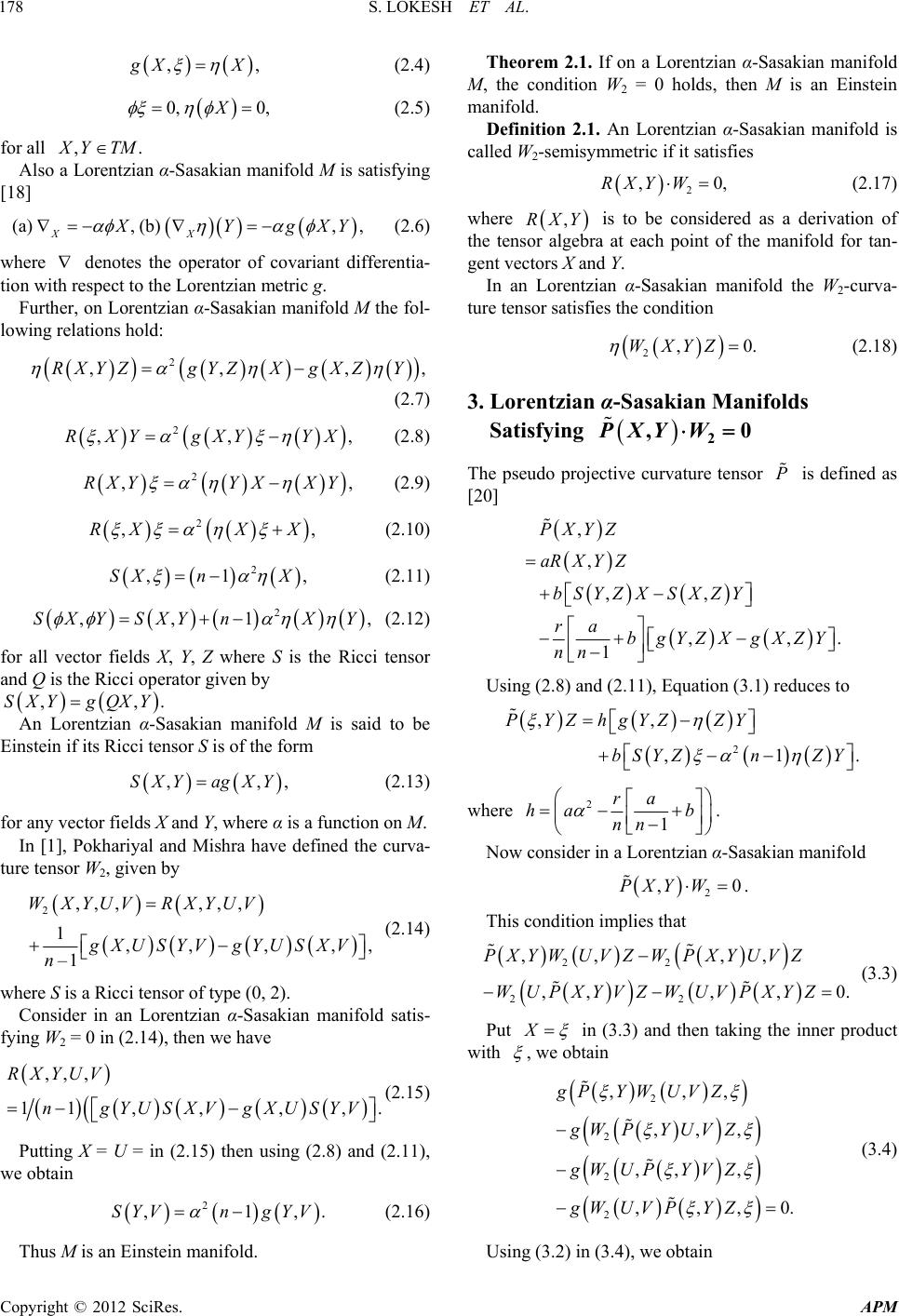 S. LOKESH ET AL. 178 ,, XX 0, 0,X (2.4) (2.5) for all ,. YTM Also a Lorentzian α-Sasakian manifold M is satisfying [18] ,(b)),,(a XX YgXY (2.6) where denotes the operator of covariant differentia- tion with respect to the Lorentzian metric g. Further, on Lorentzian α-Sasakian manifold M the fol- lowing relations hold: 2,,XZY 2 ,,,RXY gXYYX ,,RX YZgYZX g (2.7) (2.8) ,X XY 2 ,RXY Y (2.9) 2 RX X ,,X 2 ,1,X 2 1 ,nX Y (2.10) SX n (2.11) ,,SXY SXY (2.12) for all vector fields X, Y, Z where S is the Ricci tensor and Q is the Ricci operator given by ,,.SXY gQXY An Lorentzian α-Sasakian manifold M is said to be Einstein if its Ricci tensor S is of the form ,,,SXY agXY (2.13) for any vector fields X and Y, where α is a function on M. In [1], Pokhariyal and Mishra have defined the curva- ture tensor W2, given by 2,, ,,, , 1,,, ,, 1n WXYUV RXYUV gXUSYV gYUSXV (2.14) where S is a Ricci tensor of type (0, 2). Consider in an Lorentzian α-Sasakian manifold satis- fying W2 = 0 in (2.14), then we have ,, , 11 ,,,,. RXYUV ngYUSXVgXUSYV ,1,.SYVn gYV (2.15) Putting X = U = in (2.15) then using (2.8) and (2.11), we obtain 2 (2.16) Thus M is an Einstein manifold. Theorem 2.1. If on a Lorentzian α-Sasakian manifold M, the condition W2 = 0 holds, then M is an Einstein manifold. Definition 2.1. An Lorentzian α-Sasakian manifold is called W2-semisymmetric if it satisfies 2 ,0,RXY W (2.17) where ,RXY is to be considered as a derivation of the tensor algebra at each point of the manifold for tan- gent vectors X and Y. In an Lorentzian α-Sasakian manifold the W2-curva- ture tensor satisfies the condition 2,0.WXYZ (2.18) 3. Lorentzian α-Sasakian Manifolds Satisfying 2 ,0 PXY W P The pseudo projective curvature tensor is defined as [20] , , ,, ,,. 1 PXY Z aRX YZ bSYZX SXZY ra bgYZXgXZY nn Using (2.8) and (2.11), Equation (3.1) reduces to 2 ,, ,1. PYZhgYZ ZY bSYZn ZY where 2 1 ra ha b nn . Now consider in a Lorentzian α-Sasakian manifold 2 ,0PXY W . This condition implies that 22 22 ,, ,, ,,,, 0. PXYW UVZWPXYUVZ WUPXYVZWUVPXYZ X (3.3) Put in (3.3) and then taking the inner product with , we obtain 2 2 2 2 ,,, ,,, ,, , ,,,0. gPYWUVZ gWPYUVZ gWUPYV Z gWUVPYZ (3.4) Using (3.2) in (3.4), we obtain Copyright © 2012 SciRes. APM 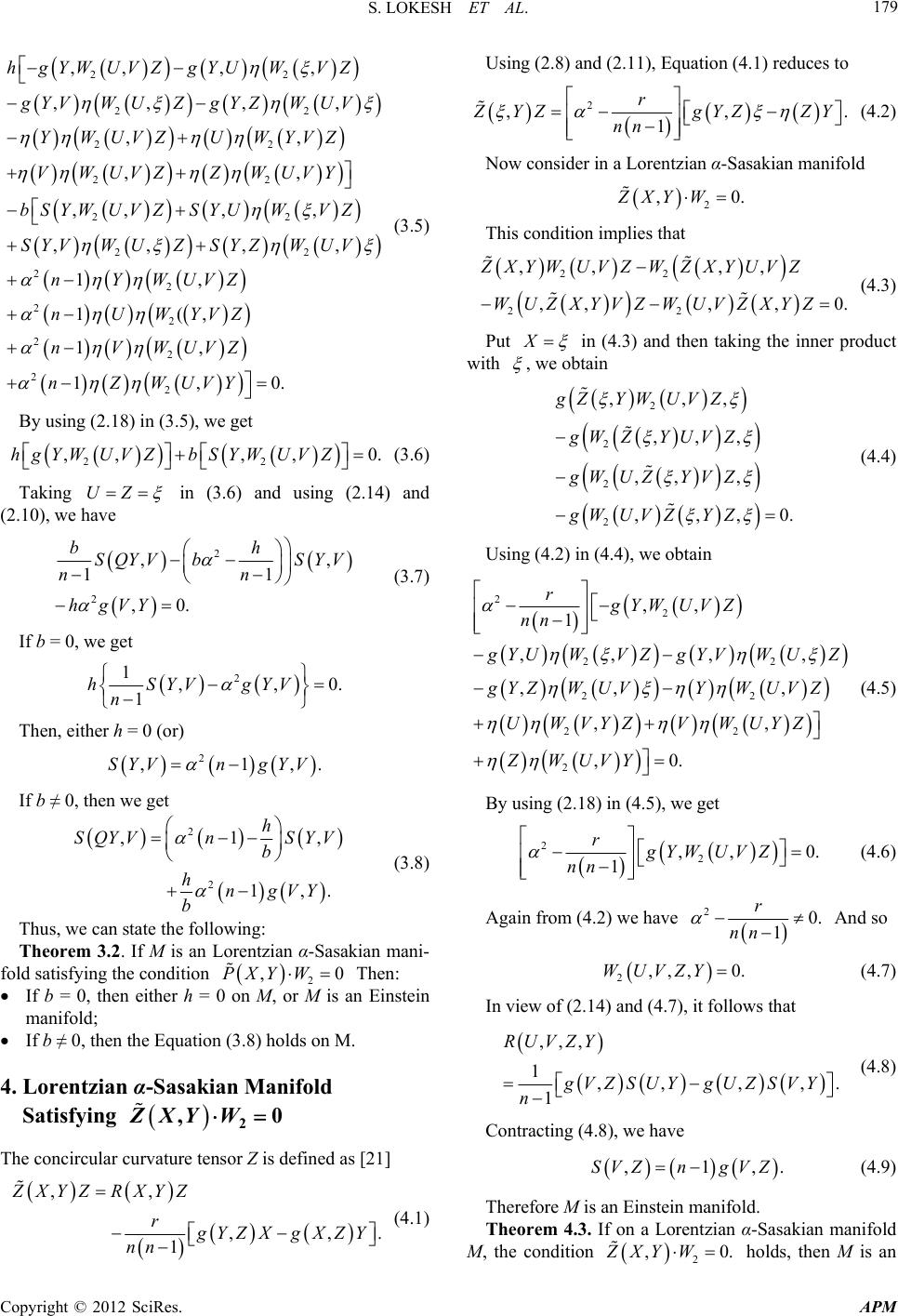 S. LOKESH ET AL. 179 22 22 22 2 2 2 2 2 2 2 2 ,,, ,, ,, , ,, 1, 1(, 1, 1, hgYWUVZ gYU gYVWUZgYZ YWUVZUW VWUVZZW bS YWUVZS YUW SYVW UZSYZ nYWUVZ nUWYVZ nVWUVZ nZWUV 22 22 22 , ,, ,, ,, , ,, W VZ W UV YVZ UVY V Z W UV 0.Y (3.5) By using (2.18) in (3.5), we get 2 , 0.UVZ UZ 2 ,, ,hgYW UVZbSYW (3.6) Taking in (3.6) and using (2.14) and (2.10), we have , 11 SYV n 2 2 , ,0. bh SQYV n hgV b Y (3.7) If b = 0, we get 2 1 1 hSYV n ,, 0.gYV ,1,.n gYV Then, either h = 0 (or) 2 SYV If b ≠ 0, then we get , 1,. hSYV b ngVY 2 2 ,1S QYVn h b (3.8) Thus, we can state the following: Theorem 3.2. If M is an Lorentzian α-Sasakian mani- fold satisfying the condition ,0Y W 2 ,0Y W 2 PX Then: If b = 0, then either h = 0 on M, or M is an Einstein manifold; If b ≠ 0, then the Equation (3.8) holds on M. 4. Lorentzian α-Sasakian Manifold Satisfying ZX The concircular curvature tensor Z is defined as [21] ,, 1 ZXYZ RXYZ r Using (2.8) and (2.11), Equation (4.1) reduces to ,, . YZX nn g XZY (4.1) 2 ,,. 1 r YZgYZ ZY nn (4.2) Now consider in a Lorentzian α-Sasakian manifold 2 ,0.ZXY W This condition implies that 22 22 ,, ,, ,,,, 0. ZXYWUVZW ZXYUVZ WUZXYVZWUVZXYZ X (4.3) Put in (4.3) and then taking the inner product with , we obtain 2 2 2 2 ,,, ,,, ,, , ,,,0. gZYW UVZ gWZYUV Z gWUZYV Z gWUV ZYZ (4.4) Using (4.2) in (4.4), we obtain 2 2 22 22 22 2 ,, 1 ,,, , ,, , ,, ,0. rgYWUV Z nn YUWVZgYVWUZ gYZW UVYW UVZ UWVYZ VWUYZ ZWUVY (4.5) By using (2.18) in (4.5), we get 2 2 ,, 0. 1 rgYWUV Z nn (4.6) Again from (4.2) we have 20. 1 r nn And so 2,,, 0.WUVZY (4.7) In view of (2.14) and (4.7), it follows that ,,, 1,, ,,. 1 RUVZY VZSUY gUZSVY n (4.8) Contracting (4.8), we have ,1,.SVZn gVZ (4.9) Therefore M is an Einstein manifold. Theorem 4.3. If on a Lorentzian α-Sasakian manifold M, the condition 2 ,0.ZXY W holds, then M is an Copyright © 2012 SciRes. APM 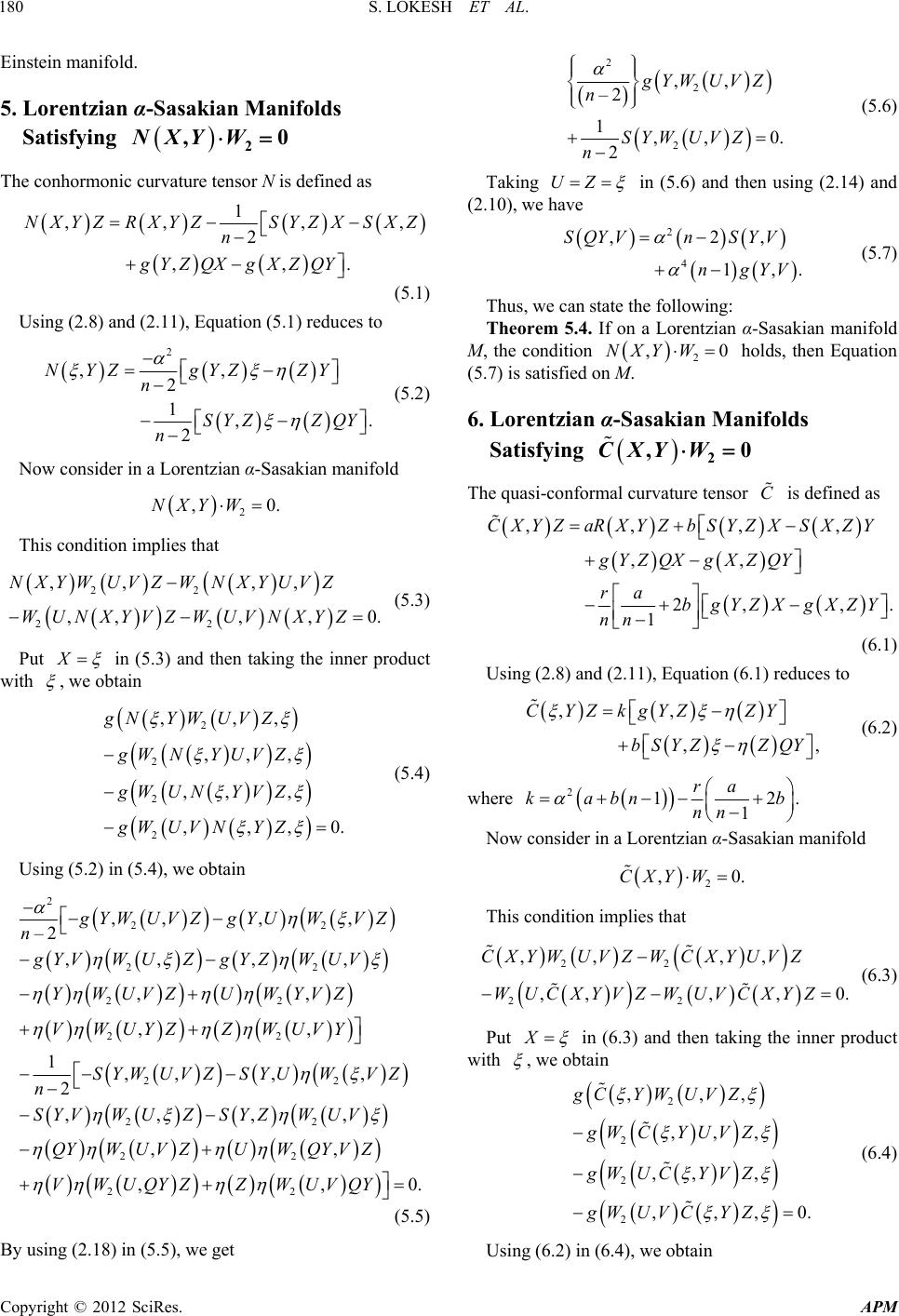 S. LOKESH ET AL. 180 Einstein manifold. 5. Lorentzian α-Sasakian Manifolds Satisfying 2 ,0YWNX The conhormonic curvature tensor N is defined as 1 ,, 2 ,, NXYZ RXYZSYZ n gYZQXgXZQ ,, . X SXZ Y (5.1) Using (2.8) and (2.11), Equation (5.1) reduces to 2 ,, 2 1 2 NYZ gYZ n SYZ n ,. ZY ZQY 2 ,0.Y W (5.2) Now consider in a Lorentzian α-Sasakian manifold NX This condition implies that 22 22 ,, ,, , NXYWUVZ W NXY W UNXYVZW UV ,, , 0. UVZ NXYZ X (5.3) Put in (5.3) and then taking the inner product with , we obtain 2 2 2 2 ,, ,, ,, ,, gNYW U gW NYU gW UNY gWUV N , , , ,0. VZ V Z V Z Y Z (5.4) Using (5.2) in (5.4), we obtain 2 2 22 22 22 22 22 22 ,, , –2 ,, , ,, ,, 1,, , 2 ,, , ,, gYWUV ZgYUW n gYVW UZgYZW YWUVZ UWY VWUYZ ZWU SYWUV ZSYU n SYVW UZSYZW QYWU VZUWQY VWUQYZ ZW 2 22 , , , , ,, 0. V Z UV VZ VY WV Z UV V Z UVQY (5.5) By using (2.18) in (5.5), we get 2 2 2 ,, –2 1,, 0. 2 YWUV Z n SYWUV Z n (5.6) UZ Taking in (5.6) and then using (2.14) and (2.10), we have 2 4 ,2, 1,. S QYVnSYV ngYV (5.7) Thus, we can state the following: Theorem 5.4. If on a Lorentzian α-Sasakian manifold M, the condition 2 ,0NXY W holds, then Equation (5.7) is satisfied on M. 6. Lorentzian α-Sasakian Manifolds Satisfying 2 ,0 CXY W C The quasi-conformal curvature tensor is defined as ,, ,, ,, 2, ,. 1 CXYZaRXYZ bSYZXSXZY gYZQXg XZQY ra bgYZXgXZY nn (6.1) Using (2.8) and (2.11), Equation (6.1) reduces to ,, ,, CYZkgYZZY bSYZ ZQY (6.2) where 212. 1 ra kabn b nn Now consider in a Lorentzian α-Sasakian manifold 2 ,0.CXY W This condition implies that 22 22 ,, ,, ,,,, 0. CXYW UVZWCXYUVZ W UCXYVZW UVCXYZ X (6.3) Put in (6.3) and then taking the inner product with , we obtain 2 2 2 2 ,,, ,,, ,, , ,,,0. gCYWUVZ gWCYUV Z gWUCYV Z gWUV CYZ (6.4) Using (6.2) in (6.4), we obtain Copyright © 2012 SciRes. APM 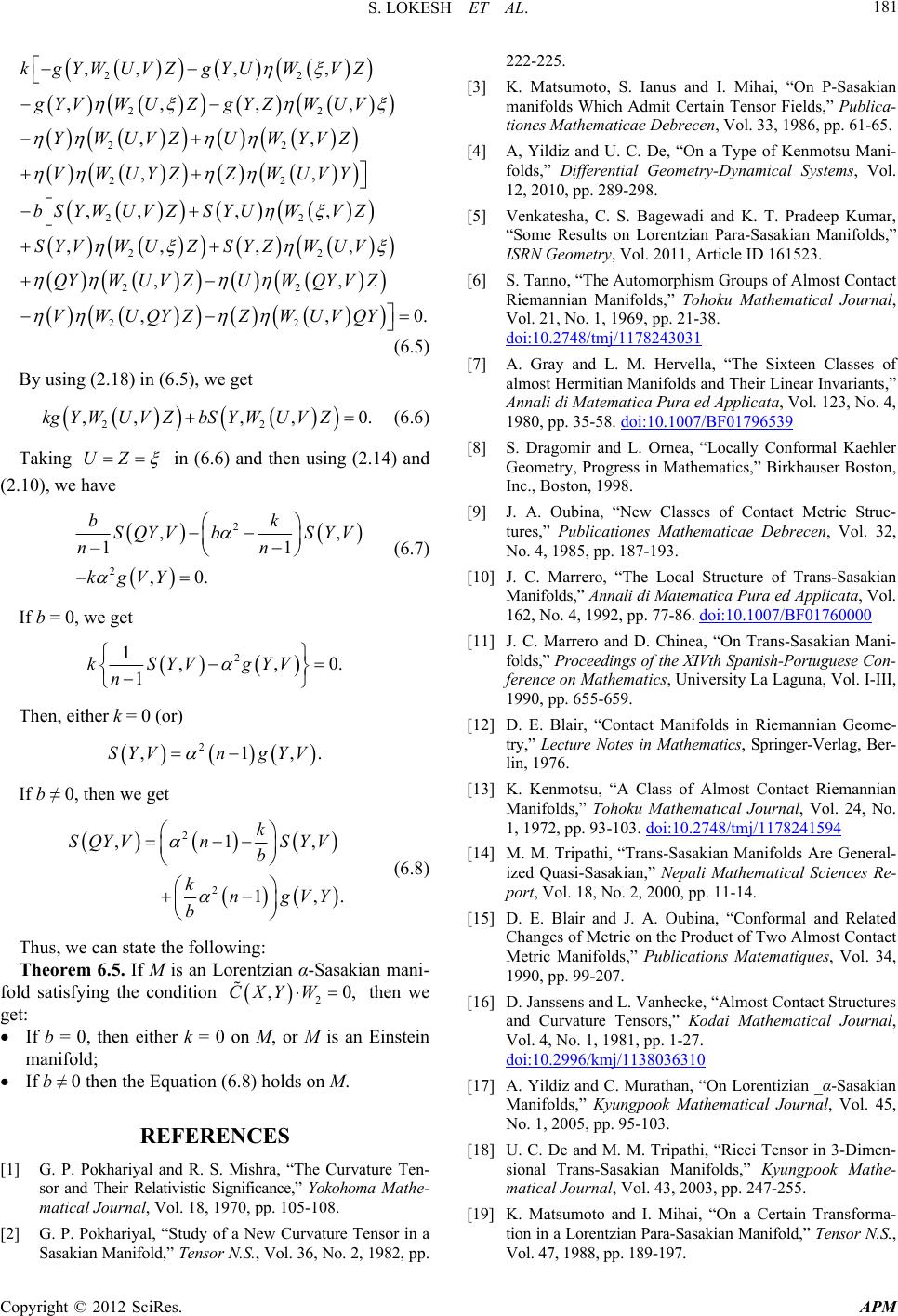 S. LOKESH ET AL. 181 2 22 22 22 2 22 22 22 ,, , ,,, ,, ,, ,, , ,,, , , kgYWUVZg YUW gYVW UZgYZW YWUVZUWY VWUYZ ZWU bS YWUVZSYUW SYVW UZSYZW QYWUVZUWQ VWUQYZ ZW 2 2 , , , , , ,0. V Z UV VZ VY V Z UV YVZ UVQY (6.5) By using (2.18) in (6.5), we get 2 ,, 0.U VZ UZ 2 ,,kgY WU VZbSY W (6.6) Taking in (6.6) and then using (2.14) and (2.10), we have , 1 bk SYV n 2 2 , –1 –,0. SQYV b n kgVY (6.7) If b = 0, we get 2 1 1 kSYV n ,, 0.gYV ,1,.n gYV Then, either k = 0 (or) 2 SYV If b ≠ 0, then we get , 1,. kS YV b ngVY 2 ,0,Y W 2 2 ,1S QYVn k b (6.8) Thus, we can state the following: Theorem 6.5. If M is an Lorentzian α-Sasakian mani- fold satisfying the condition then we get: CX If b = 0, then either k = 0 on M, or M is an Einstein manifold; If b ≠ 0 then the Equation (6.8) holds on M. REFERENCES [1] G. P. Pokhariyal and R. S. Mishra, “The Curvature Ten- sor and Their Relativistic Significance,” Yokohoma Mathe- matical Journal, Vol. 18, 1970, pp. 105-108. [2] G. P. Pokhariyal, “Study of a New Curvature Tensor in a Sasakian Manifold,” Tensor N.S., Vol. 36, No. 2, 1982, pp. 222-225. [3] K. Matsumoto, S. Ianus and I. Mihai, “On P-Sasakian manifolds Which Admit Certain Tensor Fields,” Publica- tiones Mathematicae Debrecen, Vol. 33, 1986, pp. 61-65. [4] A, Yildiz and U. C. De, “On a Type of Kenmotsu Mani- folds,” Differential Geometry-Dynamical Systems, Vol. 12, 2010, pp. 289-298. [5] Venkatesha, C. S. Bagewadi and K. T. Pradeep Kumar, “Some Results on Lorentzian Para-Sasakian Manifolds,” ISRN Geometry, Vol. 2011, Article ID 161523. [6] S. Tanno, “The Automorphism Groups of Almost Contact Riemannian Manifolds,” Tohoku Mathematical Journal, Vol. 21, No. 1, 1969, pp. 21-38. doi:10.2748/tmj/1178243031 [7] A. Gray and L. M. Hervella, “The Sixteen Classes of almost Hermitian Manifolds and Their Linear Invariants,” Annali di Matematica Pura ed Applicata, Vol. 123, No. 4, 1980, pp. 35-58. doi:10.1007/BF01796539 [8] S. Dragomir and L. Ornea, “Locally Conformal Kaehler Geometry, Progress in Mathematics,” Birkhauser Boston, Inc., Boston, 1998. [9] J. A. Oubina, “New Classes of Contact Metric Struc- tures,” Publicationes Mathematicae Debrecen, Vol. 32, No. 4, 1985, pp. 187-193. [10] J. C. Marrero, “The Local Structure of Trans-Sasakian Manifolds,” Annali di Matematica Pura ed Applicata, Vol. 162, No. 4, 1992, pp. 77-86. doi:10.1007/BF01760000 [11] J. C. Marrero and D. Chinea, “On Trans-Sasakian Mani- folds,” Proceedings of the XIVth Spanish-Portuguese Con- ference on Mathematics, University La Laguna, Vol. I-III, 1990, pp. 655-659. [12] D. E. Blair, “Contact Manifolds in Riemannian Geome- try,” Lecture Notes in Mathematics, Springer-Verlag, Ber- lin, 1976. [13] K. Kenmotsu, “A Class of Almost Contact Riemannian Manifolds,” Tohoku Mathematical Journal, Vol. 24, No. 1, 1972, pp. 93-103. doi:10.2748/tmj/1178241594 [14] M. M. Tripathi, “Trans-Sasakian Manifolds Are General- ized Quasi-Sasakian,” Nepali Mathematical Sciences Re- port, Vol. 18, No. 2, 2000, pp. 11-14. [15] D. E. Blair and J. A. Oubina, “Conformal and Related Changes of Metric on the Product of Two Almost Contact Metric Manifolds,” Publications Matematiques, Vol. 34, 1990, pp. 99-207. [16] D. Janssens and L. Vanhecke, “Almost Contact Structures and Curvature Tensors,” Kodai Mathematical Journal, Vol. 4, No. 1, 1981, pp. 1-27. doi:10.2996/kmj/1138036310 [17] A. Yildiz and C. Murathan, “On Lorentizian _α-Sasakian Manifolds,” Kyungpook Mathematical Journal, Vol. 45, No. 1, 2005, pp. 95-103. [18] U. C. De and M. M. Tripathi, “Ricci Tensor in 3-Dimen- sional Trans-Sasakian Manifolds,” Kyungpook Mathe- matical Journal, Vol. 43, 2003, pp. 247-255. [19] K. Matsumoto and I. Mihai, “On a Certain Transforma- tion in a Lorentzian Para-Sasakian Manifold,” Tensor N.S., Vol. 47, 1988, pp. 189-197. Copyright © 2012 SciRes. APM 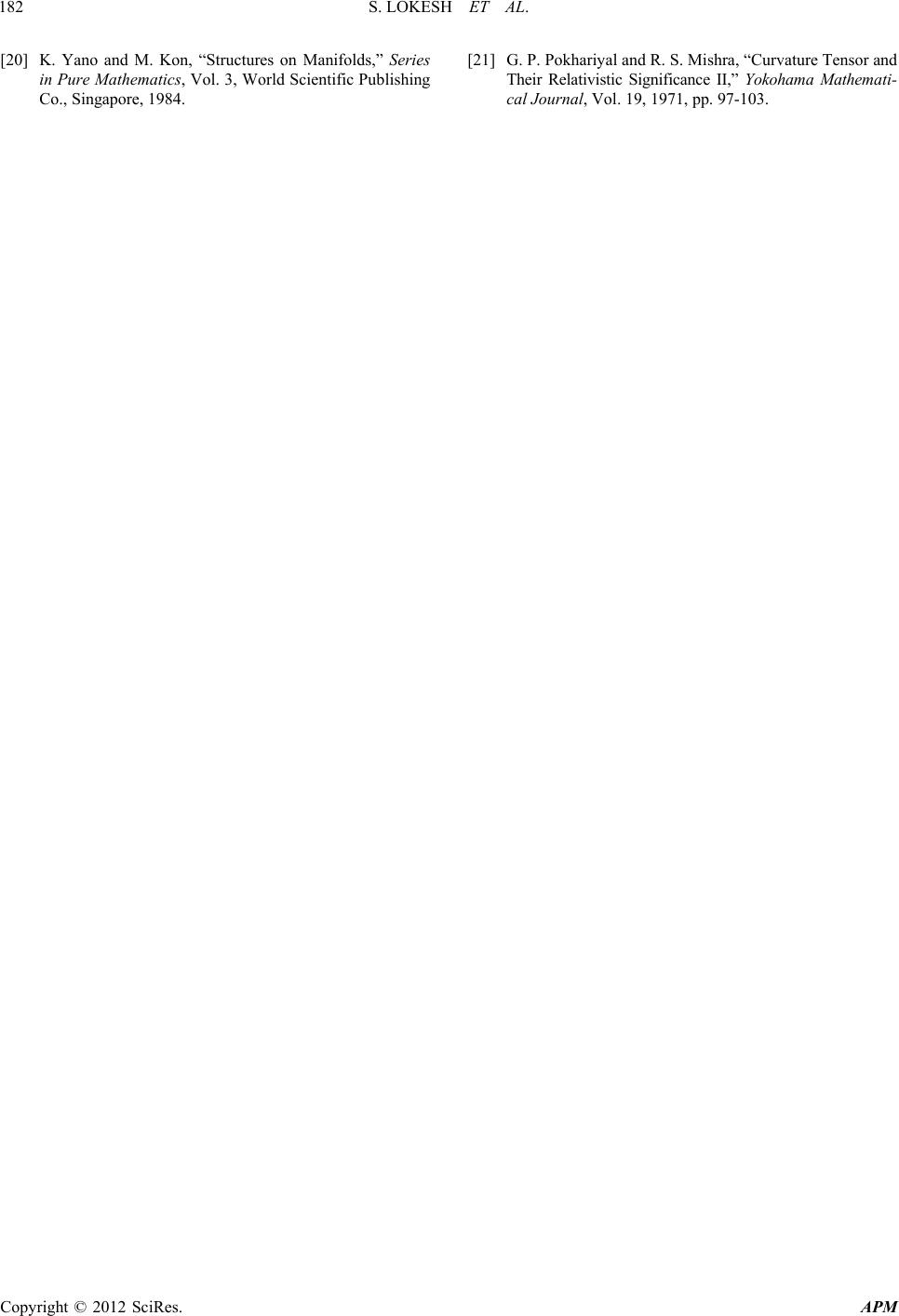 S. LOKESH ET AL. Copyright © 2012 SciRes. APM 182 [20] K. Yano and M. Kon, “Structures on Manifolds,” Series in Pure Mathematics, Vol. 3, World Scientific Publishing Co., Singapore, 1984. [21] G. P. Pokhariyal and R. S. Mishra, “Curvature Tensor and Their Relativistic Significance II,” Yokohama Mathemati- cal Journal, Vol. 19, 1971, pp. 97-103.
|